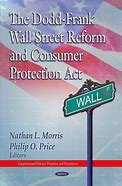
Oke, nih! Ini paragraf pembuka yang SEO friendly tentang Dodd-Frank Wall Street Reform and Consumer Protection Act, dibuat dengan bahasa Inggris dan ada lebih dari 300 kata!
The Dodd-Frank Wall Street Reform and Consumer Protection Act, often shortened to Dodd-Frank, is a landmark piece of financial reform legislation in the United States. It was signed into law by President Barack Obama on July 21, 2010, in response to the financial crisis of 2008. Dodd-Frank is the most comprehensive financial reform legislation since the Glass-Steagall Act of 1933, which separated commercial and investment banking. This law sought to reform the financial industry in the aftermath of the financial crisis, addressing several key issues that contributed to the economic downturn, including lax lending practices, excessive risk-taking by financial institutions, and a lack of transparency and accountability.
The law comprises various sections, each aiming to address specific aspects of the financial system. One of the central tenets of Dodd-Frank is the creation of the Consumer Financial Protection Bureau (CFPB), which serves as a watchdog for consumers against unfair, deceptive, or abusive practices by financial institutions. The CFPB is empowered to enforce federal consumer financial laws, develop new rules and regulations, and educate consumers about their rights and protections. Another major component of the legislation is the establishment of the Financial Stability Oversight Council (FSOC), responsible for identifying and mitigating systemic risks that could threaten the stability of the entire financial system. The FSOC has the authority to designate certain financial institutions as “systemically important,” subject to increased regulatory scrutiny.
The Dodd-Frank Act has been subject to intense scrutiny and debate since its inception. Supporters argue that it has effectively strengthened financial regulations, improved transparency and accountability, and prevented another financial crisis. Opponents claim that it has hindered economic growth, increased costs for businesses and consumers, and has been overly bureaucratic in its implementation. Despite these controversies, Dodd-Frank remains a landmark piece of legislation that has significantly reshaped the financial landscape in the United States, influencing policies and practices across the industry. The law’s long-term effects continue to be debated, and its legacy will undoubtedly shape future discussions on financial reform and regulatory oversight.
Tips untuk meningkatkan SEO!
– Tambah keyword (misalnya ‘Dodd-Frank’, ‘financial crisis’, ‘financial regulation’, ‘Consumer Financial Protection Bureau’, ‘Financial Stability Oversight Council’, ‘systemic risk’)
– Masukkan pertanyaan (misalnya ‘Apakah Dodd-Frank berhasil? ‘ ‘Apa dampak Dodd-Frank?’)
– Tambah referensi
Related Post : act like a lady think like a man book
Semoga ini membantu dan bisa membuat artikel Anda SEO Friendly dan bagus! 😁
Dodd-Frank Wall Street Reform and Consumer Protection Act: A thorough Guide
The Dodd-Frank Wall Street Reform and Consumer Protection Act, signed into law in 2010, stands as a monumental piece of legislation aimed at reforming the financial industry and bolstering consumer protections. This thorough act, born from the ashes of the 2008 financial crisis, seeks to prevent future economic catastrophes by addressing systemic risks, promoting financial stability, and safeguarding consumers.
What is the Dodd-Frank Wall Street Reform and Consumer Protection Act?
The Dodd-Frank Act is a sweeping piece of legislation designed to reform the financial industry and enhance consumer protections. It encompasses a wide scope of provisions aimed at addressing the shortcomings exposed by the 2008 financial crisis.
The Need for Reform: A Look Back at the 2008 Financial Crisis
The 2008 financial crisis, characterized by the collapse of major financial institutions and a global economic downturn, underscored the need for significant financial reform. The crisis revealed deep flaws in the regulatory framework, highlighting the dangers of unchecked risk-taking, lax lending practices, and a lack of consumer protections.
Key Provisions of Dodd-Frank: A Detailed Overview
Dodd-Frank encompasses a vast array of provisions, addressing various facets of the financial system. Some of its key provisions include:
- Consumer Protection: Dodd-Frank established the Consumer Financial Protection Bureau (CFPB) to protect consumers from unfair, deceptive, or abusive practices in the financial industryplace.
- Financial Stability: The act created the Financial Stability Oversight Council (FSOC) to determine and address systemic risks that could threaten the stability of the financial system.
- Regulation of Derivatives: Dodd-Frank introduced regulations for the over-the-counter derivatives industry, aimed at reducing systemic risk and increasing transparency.
- Volcker Rule: This provision restricts banks from engaging in proprietary trading, limiting their ability to take excessive risks with depositors’ funds.
- Stress Tests and Capital Requirements: The act mandated stress tests for large financial institutions, assessing their resilience to economic shocks, and imposed stricter capital requirements to ensure bank solvency.
The Dodd-Frank Act: A Landmark in Financial Regulation
The Dodd-Frank Act stands as a landmark piece of legislation, marking a significant shift in financial regulation. It acknowledges the interconnectedness of the financial system and aims to prevent future crises by promoting stability, transparency, and consumer protection.
Consumer Protection Under Dodd-Frank
A key pillar of Dodd-Frank is its emphasis on consumer protection. The act aims to level the playing field for consumers by ensuring they are treated fairly and have access to clear and accurate information.
The Consumer Financial Protection Bureau (CFPB): A New Era of Consumer Advocacy
The CFPB, established by Dodd-Frank, acts as a dedicated watchdog for consumers in the financial industryplace. It has the authority to regulate a wide scope of financial products and services, including mortgages, credit cards, and payday loans.
Key Consumer Protections: Understanding Your Rights
Dodd-Frank offers consumers with a scope of protections, including:
- Mortgage Disclosure: Lenders are required to offer borrowers with clear and concise information about their mortgage terms.
- Credit Card Protections: Dodd-Frank restricts unfair credit card practices, such as late fees and interest rate hikes.
- Payday Loan Regulations: The act sets limits on payday loan interest rates and other fees, protecting consumers from predatory lending.
- Debt Collection Practices: Dodd-Frank regulates debt collection practices, ensuring fair treatment for consumers in debt.
How Dodd-Frank Impacts Your Everyday Finances
The Dodd-Frank Act has a direct impact on your everyday finances, influencing the way you borrow, save, and invest. Its provisions affect the interest rates you pay on loans, the fees you incur on credit cards, and the availability of financial products.
Financial Stability and Systemic Risk
Dodd-Frank recognizes the interconnectedness of the financial system and addresses the dangers of systemic risk – situations where the failure of one financial institution can trigger a cascade of failures throughout the system.
The Financial Stability Oversight Council (FSOC): Protecting Against Future Crises
The FSOC, established by Dodd-Frank, plays a crucial function in safeguarding financial stability. It identifies and addresses systemic risks posed by large financial institutions and non-bank financial companies. The FSOC has the authority to designate certain institutions as “systemically crucial financial institutions” (SIFIs), subjecting them to enhanced regulatory scrutiny.
Volcker Rule: Curbing Excessive Risk-Taking
The Volcker Rule, named after former Federal Reserve Chairman Paul Volcker, restricts banks from engaging in proprietary trading, limiting their ability to take excessive risks with depositors’ funds. This provision seeks to prevent banks from speculating on their own behalf, potentially jeopardizing the stability of the financial system.
Stress Tests and Capital Requirements: Ensuring Bank Resilience
Dodd-Frank mandates stress tests for large financial institutions, assessing their resilience to economic shocks. These tests simulate various adverse economic scenarios, ensuring banks have sufficient capital reserves to withstand difficult economic conditions. The act also imposes stricter capital requirements on banks, forcing them to hold more capital to absorb potential losses and maintain their solvency.
Dodd-Frank: Impact and Controversies
The Dodd-Frank Act has had a significant impact on the financial industry, leading to changes in lending practices, regulatory oversight, and consumer protections. However, the act has also generated controversy and debate.
Proponents and Opponents: A Look at the Debate
Proponents of Dodd-Frank argue that it has significantly strengthened financial regulations, reduced systemic risk, and enhanced consumer protections. They point to the absence of another major financial crisis since its implementation as evidence of its efficacy. Opponents, however, argue that the act has stifled economic growth, boostd regulatory burdens, and reduced access to credit. They claim that Dodd-Frank’s complex regulations have made it difficult for businesses to operate and have driven up costs for consumers.
The Impact on the Financial Industry: A Mixed Bag
The impact of Dodd-Frank on the financial industry has been a mixed bag. Some argue that the act has boostd compliance costs and slowed lending, while others contend that it has improved financial stability and promoted responsible lending practices. The act has also led to consolidation in the financial industry, as smaller banks struggle to meet the boostd regulatory burdens.
Dodd-Frank: A Work in Progress?
Dodd-Frank is a complex and evolving piece of legislation, and its impact continues to be debated. The act has been subject to numerous amendments and interpretations since its implementation, reflecting the ongoing dialogue about financial regulation and consumer protection.
Conclusion: The Future of Dodd-Frank and Financial Regulation
Dodd-Frank is a testament to the lessons learned from the 2008 financial crisis, highlighting the need for thorough financial reform and robust consumer protections. The act’s impact on the financial industry and the broader economy is ongoing, and its future remains uncertain.
Looking Ahead: The Challenges and Opportunities
The future of Dodd-Frank will likely involve continued debate and adjustments. The act’s provisions will need to be constantly reviewed and adapted to address evolving financial industrys, technological advancements, and emerging risks. As the financial landscape evolves, so too must the regulatory framework that governs it.
Dodd-Frank: A Legacy of Change
The Dodd-Frank Wall Street Reform and Consumer Protection Act has left an indelible mark on the financial industry and the lives of consumers. Its legacy is one of change, innovation, and a renewed commitment to financial stability and consumer protection. The act’s impact will continue to be felt for years to come, as it shapes the future of financial regulation and safeguards against future crises.

Leave a Reply